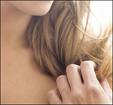
by theglamscientist | | hair, hair care, hair conditioning, hair damage, hair elasticity, healthy hair |

Elasticity is a very important factor in assessing the strength of hair. The elasticity of the hair is an indicator of what styles and/or processes your hair can withstand. When hair has low elasticity, it will not hold a curl well (thermal or wet styled) and it is more prone to damage caused by styling and chemical treatments. Basically, hair with low elasticity is weak and must be handled with care.
Chemical treatments including relaxers, permanent wave, color and even keratin should be preceded by an elasticity strand test to ensure minimal (ideally zero) breakage occurs. But you should also consider performing an elasticity test before going to wacky with the hooded dryer, blow dryer, round brush and flat iron because this requires good elasticity, too. One way to test your hair’s elasticity is to take a [full length] strand of hair from your comb or brush. Hold the strand with the index finger and thumb of both hands about 2 inches apart. Quickly and firmly pull the strand of hair. If the strand snaps, it has low elasticity; If it remains in tack, it has good elasticity.
Another strand test that is equally as fun is what I call the “ribbon curl” test. Hold a strand of hair between the index finger and thumb of one hand. With the index finger and thumb of the opposite hand, use your thumb nail to firmly run along the length of the strand so that it curls. — This is similar to curling a ribbon with scissors. — Now stretch the curl until the strand is straight then let it go. If the strand returns to the original curl pattern, it has good elasticity. If it returns to at least half the original curl, it has moderate elasticity. If it stays straight, your hair is in bad shape :(.
Many factors affect the elasticity of the hair. Excessive heat styling, combing/brushing when the hair is wet and chemical treatments can all have a devastating effect on your hair’s level of elasticity. If after performing the strand test you find that your hair has low elasticity, avoid all of the above styling faux pas. Hair elasticity can be improved by giving your hair what it lacks… PROTEIN! Hair is 100% protein (keratin). Hair with low elasticity has weaker protein bonds than that of good elasticity. Nevertheless protein treatments are a good idea for everyone sooooo… Run, run, run to your nearest beauty supply to purchase a deep conditioning protein treatment.
Here’s to the Glam Life!
by theglamscientist | | hair care, hair damage, hair growth, health food, humectant |
In the previous posts for the Long, Luxurious Hair Series, we discussed the science behind hair growth and factors that negatively affect the growth process. Armed with that information, we are now able to investigate ways to optimize individual hair growth cycles. The key is to protect the hair from extensive damage and breakage.
The very best way to promote healthy hair growth is from the inside out. Incorporating foods that aid in hair growth and strength is a healthy and safe way to reach the ultimate goal. Hair is made primarily of a strong protein called keratin which is also found in skin and nails. Variations in the amino acids found in keratin account for the differences in texture with some being soft and/flexible and some being hard. Since hair is made of protein, eating foods that are high in protein will be beneficial to the condition of the hair. Iron, B Vitamins, Essential Fatty Acids, Vitamin E and sulfur are also good additions to a healthy hair diet. Adding more of the following foods will be a good start: fish, eggs, leafy green vegetables, yogurt and nuts. Experimenting with different recipes that include these foods is a fun way to change your diet. Stear clear of hair growth supplements, they are potentially dangerous and unnecessary.
Aside from altering your eating habits, there are some topical hair treatments that will help to repair and prevent damage. Moisture is a must for healthy hair. Dry hair is often brittle and easily broken. It is important to note that hair oil products are not moisturizing products. Good moisturizing products will infuse moisture (water) in the hair shaft which hydrates the cuticle layer helping to create shine and prevent breakage and/or split ends. Use shampoos and conditioners that have humectants in the ingredients list. Humectants draw moisture to the hair and hold it there. Some humectants are glycerin, honey, sugar cane, hydrolyzed wheat starch, sodium PCA, panthenol, sorbitol, propylene glycol, butylene glycol and acetamide MEA. Also be sure to avoid of sulfates and alcohol which strip the hair of its natural oils.
Heat styling can cause damage to the hair shaft when used in excess. In addition to minimizing the use of heat, you should invest in thermal styling hair products which help to protect the hair from permanent damage and usually have other nutritive properties.
Finally, having your ends trimmed on a regular basis is your hair’s very best friend. Split ends are not only unsightly, but they spread. Ragged ends easily get tangled with other strands of hair and cause breakage when the hair is combed or brushed. Uncontrolled split ends continue to split, higher and higher up the hair shaft causing frizzy, dry, damaged looking hair. When this sort of damage is finally addressed, the hair has to be cut much more than it would had it been dealt with early. Most stylists recommend a scheduled trim every six weeks.
In the final post of the series, we will discuss a technique to maintaining healthy hair for optimal hair growth.
by theglamscientist | | hair care, hair damage, hair growth, hair relaxer |

Before I begin discussing “The Enemy”, I’d like to give a brief and blunt recap of Part I. Simply put, a person’s hair will grow only to the length that their individual growth cycle allows. There is no product or technique that will extend your unique hair growth cycle. That being said, healthy hair should be the ultimate goal. The result of improperly cared for hair is breakage. Naturally breakage abbreviates the potential length of your hair. There are several culprits which negatively affect the hair growth cycle. Included are heat, chemicals and styling products. Here’s why:
The most key fact in understanding “The Enemy” is knowing that by the time the hair emerges from the scalp, it is no longer alive. Consider a fresh flower arrangement. Once the flowers are cut, they are no longer receiving a continual supply of the nutrients needed to survive. As the recipient of the flowers, we do all we can to keep the flowers in bloom for as long as possible. We clip the stems at just the right angle, put them in water, add plant food, prune the leaves, etc. Similarly, our hair needs just as much TLC.
Heat styling can be both beneficial and counter-productive. The benefits will be discussed in Part III. When heat is applied to the hair, it breaks the hydrogen bonds (water molecules) found on the cuticle layer. The cuticle layer is then opened and the hair is able to be reshaped and maintains this new shape upon cooling. When water, in liquid or steam form, is introduced, the hydrogen bonds reform and the hair returns to its natural state. Excessive use of heat causes severe damage to the cuticle layer which will eventually lose its ability to “bounce back”, thus breakage results.
The majority of American women have chemically altered their hair at some point. This includes permanent waves (perms/jerry curls), relaxers and permanent color treatments. Each involves the use of strong acids or bases which just aren’t pretty for anything dead or alive. I’m sure I don’t need to prove that, each of those treatments will cause chemical burns on the scalp if left on too long. Damage to the cuticle layer from these processes is inevitable. In the case of permanent color treatments, the product is meant to literally strip the cuticle layer until the desired color is acheived. Sounds painful!
Styling products are not such harsh villains, but they can cause significant damage nonetheless. Typically, mousse, styling/sculpting gel, holding spray, etc contain alcohol which can be very drying to the hair. Paired with the heat from a blow dryer, curling or flat iron, the hair shaft suffers a great deal of damage apparent by split ends and breakage.
Look for Part III where I will discuss how to fight the enemy yet still enjoy the styling we love.



